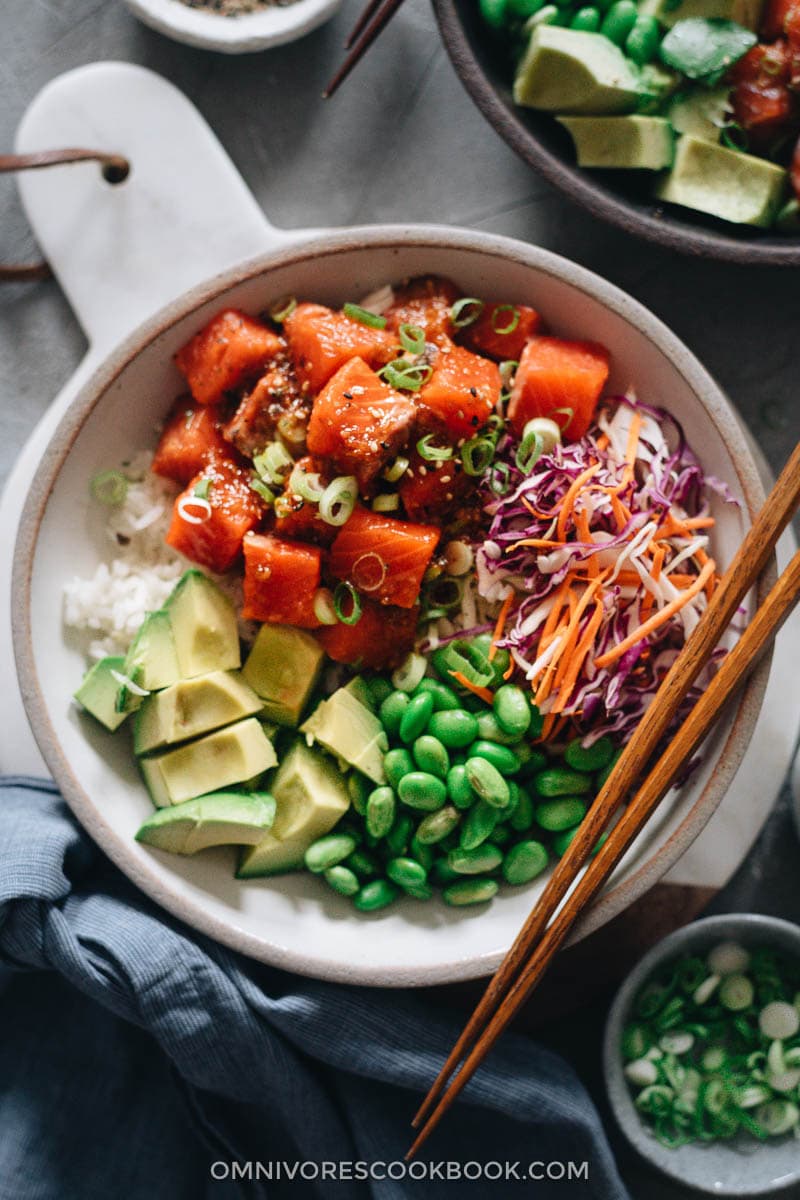
Summer means poke!
Mmm… There’s really only one dish I crave when I’m hankering for a delicious combination of contrasting textures and vibrant colors and flavors that take me to the beach. A main dish of native Hawaiian cuisine, poke is basically diced raw fish, traditionally tuna, salmon, or octopus, marinated in Asian seasonings. It has strong Japanese influences, which is why the traditional marinade is made from ingredients such as soy sauce and rice vinegar.
My approach to the recipe was to keep it simple and refreshing. I used the traditional approach with fresh aromatics to create a rich sauce that goes perfectly with the salmon.
The other day, when I was testing the recipe, my friend came over and insisted I let him try it out. I was so nervous because he’s from Hawaii. To my biggest relief, he LOVED the taste and finished the whole bowl. So I’m proud to say that this recipe is Hawaiian-approved!
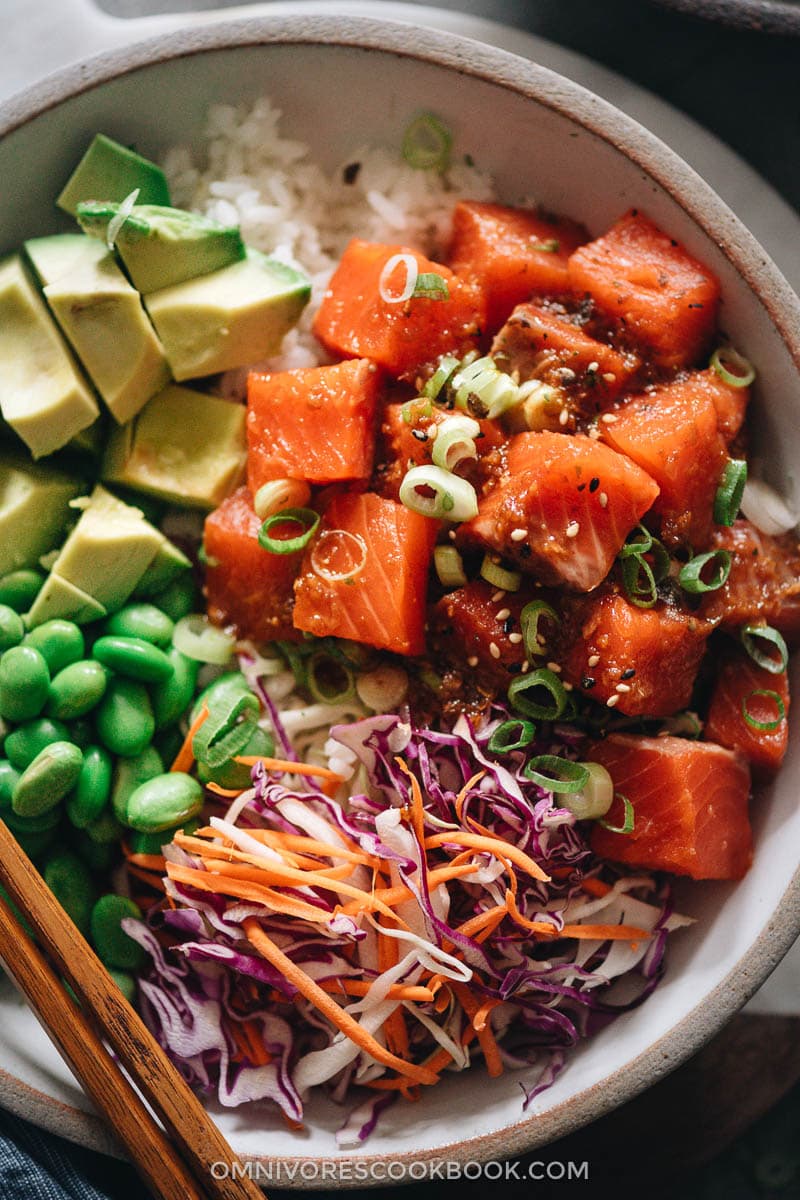
An introduction to sushi-grade salmon
Why frozen salmon
Choosing a high-quality salmon not only makes a difference in the taste of your dish, but for raw seafood especially, you want to make sure it’s 100% clean and safe to eat.
The FDA Food Code states that fish eaten raw should be frozen at -4 degrees Fahrenheit for a minimum of seven days, or for 15 hours at a temperature of -31 degrees F. Fish for sushi usually uses the latter approach, called flash freezing. The process kills the parasites while retaining the texture of the fish. And you can usually find a “sushi grade” label on fish that’s processed this way.
That’s why a poke recipe usually recommends using frozen salmon instead of fresh salmon.
Where to buy sushi-grade salmon
You can usually find sushi-grade salmon in a high-end grocery store, in the freezer session near the fish and seafood section. For example, the Whole Foods near us carries various kinds of sushi-grade fish – skinned, cut into rectangular pieces, and packaged in boxes. When I was living in Austin, we usually went to Central Market to buy sushi-grade salmon and tuna.
For this recipe, I used Sockeye salmon from the Copper River Prince William Sound Marketing Association. It’s a non-profit in rural Alaska that works on behalf of 540 fishing families to help share their stories and their salmon with the world. Copper River salmon are handled with extreme care on their journey from net to plate. Their Sockeye salmon is robust and rich in flavor with a firm texture that makes it perfect for a poke bowl.
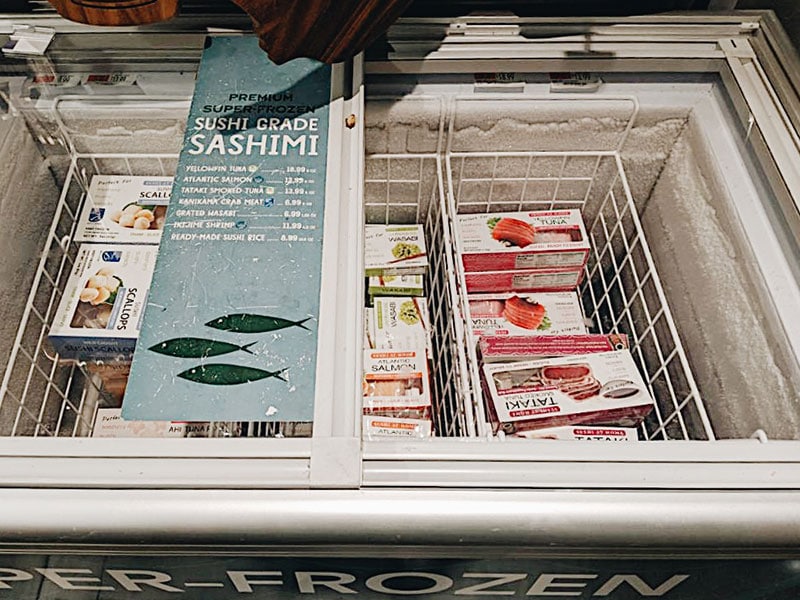
What to do if you cannot find sushi-grade salmo
Not all salmon have parasites. But they are usually more susceptible to parasites than other types of fish such as tuna. That’s why it’s always a good idea to buy frozen salmon.
But when you cannot find sushi-grade salmon, using wild-caught salmon from a reliable source might be your next best option.
Living in the wild and eating their natural diet, wild-caught salmon have a lower risk of contamination from man-made toxins. Also, they’re less likely to be exposed to antibiotics, pesticides, colorings, and other harmful substances used in some farm-raised fish. Farm-raised salmon usually grow up in poor crowded conditions, with higher rates of bacteria, parasites, and diseases.
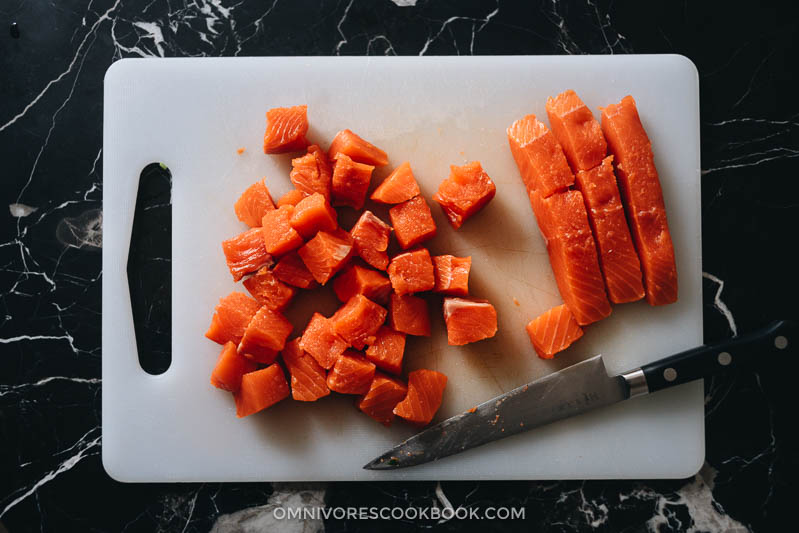
Cooking notes
1. How to fast prepping the sauce
It’s important to finely grate the aromatics, so you won’t bite into big chunks of ginger and garlic. I usually use a garlic press to finely grate the garlic and a lemon zester to grate the ginger. Not only does this speed up your prep, but it also makes your sauce texture really fine.
Alternatively, you can mix the sauce ingredients with a hand blender.
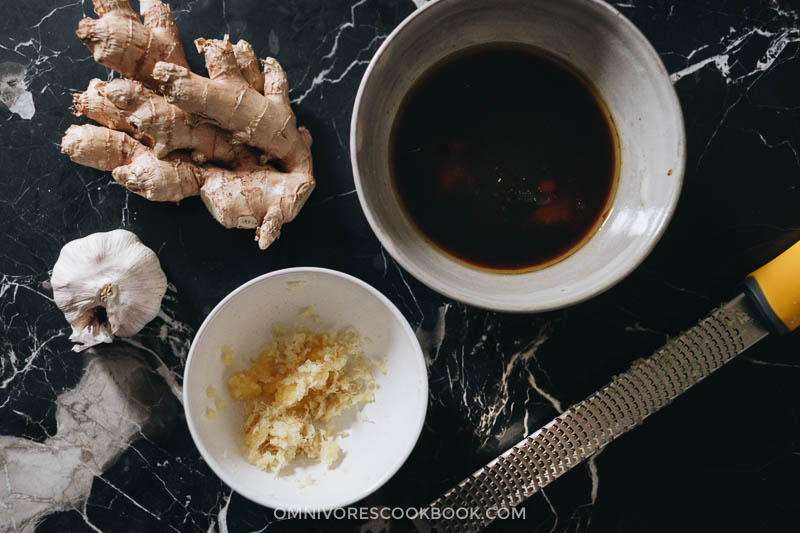
2. Make sushi rice (optional but highly recommended)
In short, sushi rice is made with short-grain white rice, steamed just like regular rice with a piece of kombu (dried seaweed), then mixed with rice vinegar and sugar while hot, and chilled to room temperature. It is super easy to make and will make your poke bowl extra delicious. My go-to sushi rice recipe is from Just One Cookbook. When I’m super lazy, I usually skip soaking the rice, adding the kombu, and mix the rice in my rice cooker bowl instead.
Of course, you can always use regular steamed rice for your poke bowl. Short grain white rice is the default grain for this recipe. But I would use brown rice or mixed grains if I wanted my dish extra healthy. I made extra sauce in this recipe, so you can drizzle more sauce onto your rice if you’re not making sushi rice.
3. Keep the toppings simple
There are many ways to garnish your poke bowl, but I find that simplicity is key.
Some common veggies that go well with the salmon poke bowl include:
- Avocado (highly recommended)
- Cabbage (or coleslaw mix)
- Blanched spinach
- Finely chopped kale, in small amounts
- Rehydrated wakame (a type of dried seaweed, usually used in Japanese salads)
- Blanched edamame
- Sliced or cubed cucumber
- Thinly sliced radish, in small amounts
I always use avocado in my salmon poke bowl, simply because it naturally goes so well with raw fish and adds a beautiful buttery texture. You can choose another one or two ingredients from the list, but you don’t want the veggies to overpower the fish.
Some nice garnishes include:
- Toasted sesame seeds
- Dried nori sheets, cut into strips
- Furikake (Japanese rice seasoning, made with sesame seeds, nori, salt, and sugar)
- Japanese pickled ginger
Many poke bowl recipes use salmon roe or other types of fish roe (caviar). If you have those on hand, it’s nice to add a small spoon to your bowl. Because fish roe are usually very salty, you should reduce the amount of sauce according to your taste.
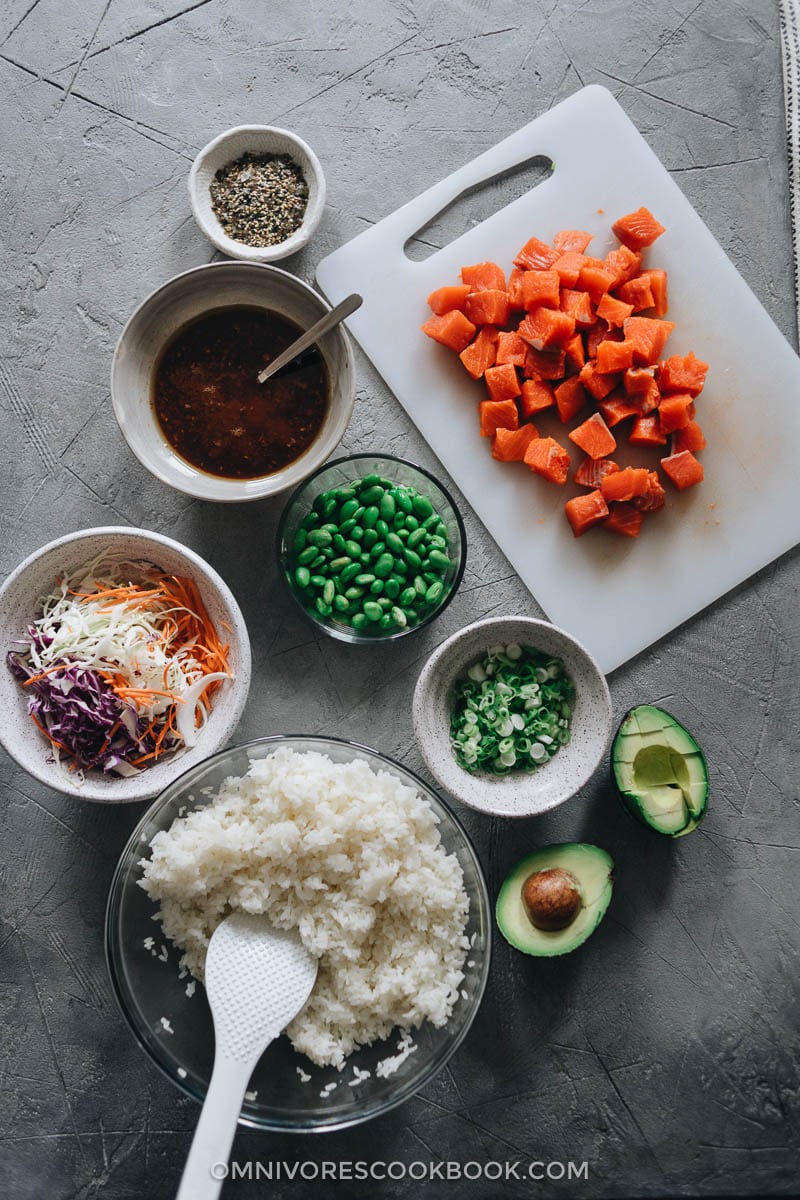
4. Storage
The salmon poke bowl tastes the best when served fresh. If you’re planning to serve the dish later, you can always make the sauce and cook the rice beforehand. It takes no time to assemble the dish.
On the other hand, if you’ve already made the poke bowl and have leftovers, you can store it in an airtight container for a day. The salmon will slowly cook in the vinegar and slightly change its texture, but the result will remain tasty.
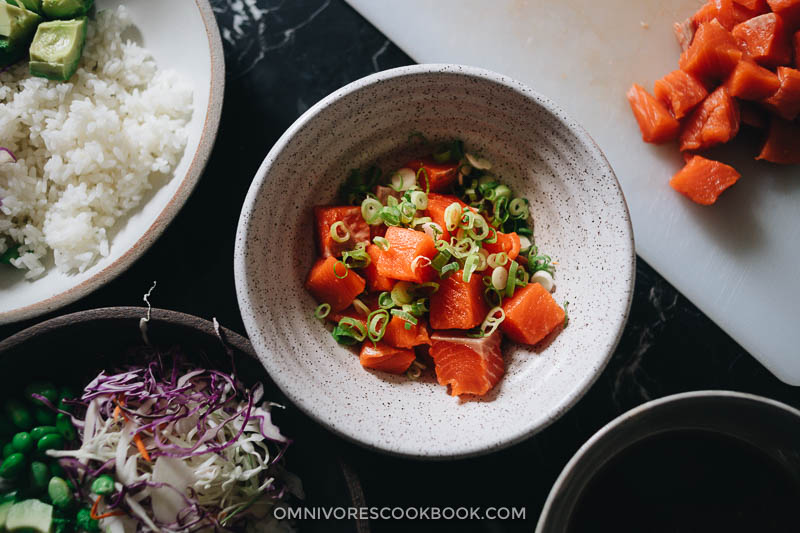
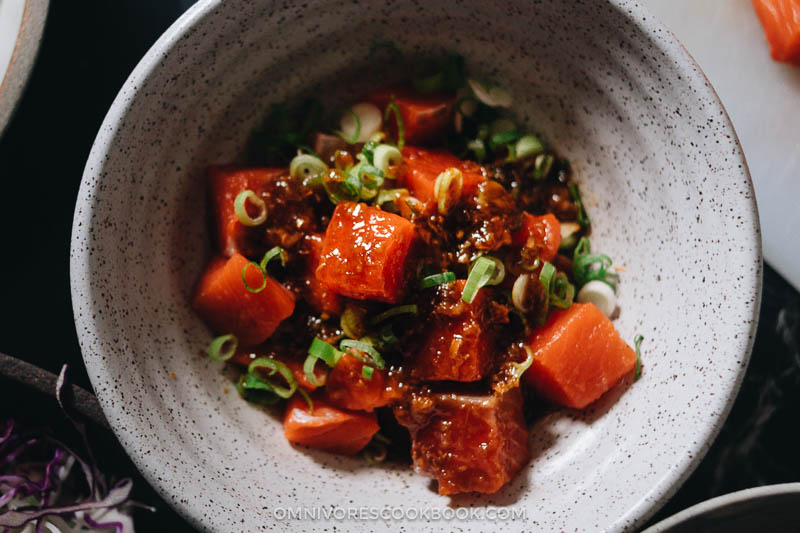
More easy dinner recipes
- 30-Minute Salmon Noodle Bowl with Coleslaw
- Chicken Udon Soup
- Easy Beef Fried Rice
- Honey Soy Sauce Glazed Salmon
- Crispy Salmon with Ginger Soy Sauce
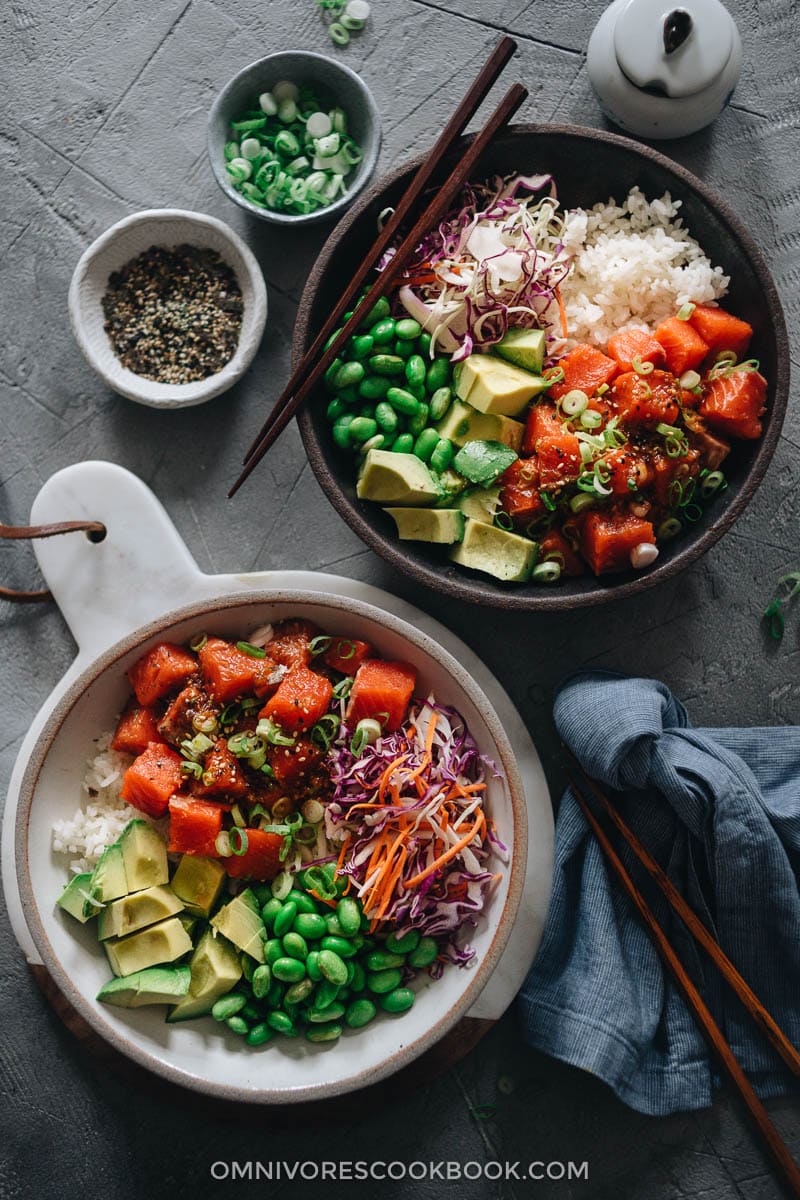
If you give this recipe a try, let us know! Leave a comment, rate it (once you’ve tried it), and take a picture and tag it @omnivorescookbook on Instagram! I’d love to see what you come up with.
Chinese Cooking Made Easy
Are you new to this website? This free email series is a great place to start. I’ll walk you through a few of my most popular recipes and show you how and why they work. You’ll quickly start to cook better Chinese food in your own kitchen.
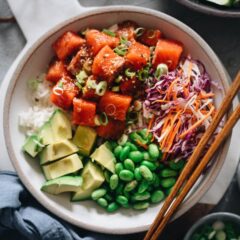
Salmon Poke Bowl
Ingredients
- 1 lb sashimi-grade salmon
- 2 green onions , thinly sliced and separated
- 4 cups cooked white rice (or brown rice, or sushi rice) (*Footnote 1)
Sauce
- 4 tablespoons soy sauce
- 2 tablespoons rice vinegar
- 2 tablespoons Sriracha
- 2 tablespoons maple syrup (or honey)
- 2 tablespoons sesame oil
- 2 cloves garlic , finely grated
- 2 teaspoons ginger , finely grated
- 1/2 teaspoon salt
Topping options
- 1 cup edamame , cooked (Optional)
- 2 cups salad greens (or coleslaw mix, or sliced purple cabbage)
- 1 large avocado , cubed (Highly recommended)
- Furikake (or toasted sesame seeds) (Optional)
Instructions
Prepare the poke
- Remove the salmon skin and discard it. Examine the salmon to see if there are any bones lodged in the meat and use a pair of fishbone tweezers remove them. Cut the salmon into 1/2-inch cubes. Add the salmon into a medium-sized bowl and set it aside.
- Add the sauce ingredients into a small bowl and mix well.
- Add the green onion to the bowl with the salmon. Pour in half of the sauce. Use a rubber spatula to gently mix the salmon until it’s evenly coated with the sauce. Taste the salmon and mix in a bit more sauce if needed.
Assemble the bowl
- Portion the rice and transfer it to each serving bowl. Add the salmon, edamame, vegetables (salad greens, coleslaw mix, or sliced purple cabbage), and avocado on top of the rice. Garnish with furikake or toasted sesame seeds. Serve the remaining sauce on the side.
- Serve immediately as a main dish.
Notes
- You can serve the poke bowl with the type of steamed rice you prefer (including brown rice, multi-grain rice, etc). Refer to the blog post above for more information on the rice. If you prefer to make sushi rice, use the recipe from Just One Cookbook.
- The nutrition facts are calculated based on 1 of the 4 servings of this recipe, including the rice and veggie toppings.
Nutrition
Have a question or feedback? Add a Comment
Did you make this? I want to see! Tag @OmnivoresCookbook on Instagram, and rate the recipe below.

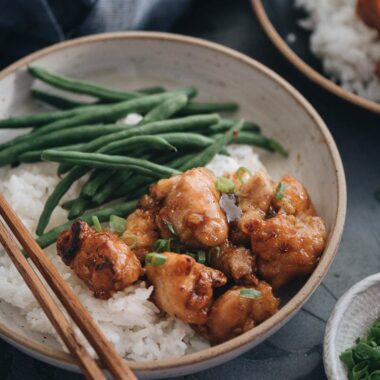
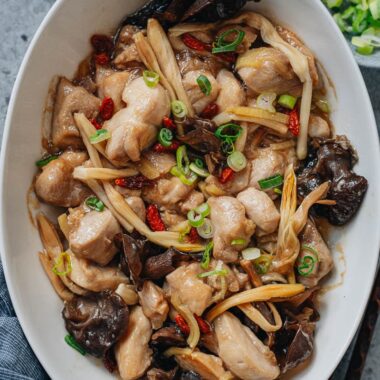
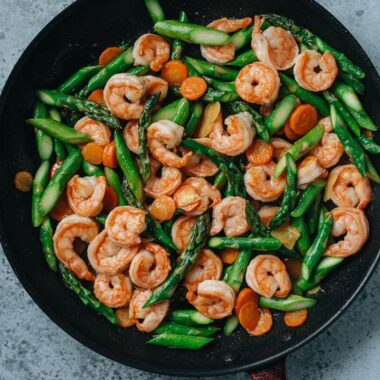
Michele
On permanent rotation. Absolutely delicious!
People who think they are sushi connoisseurs and only eat cooked rolls really shouldn’t comment. Some the fish is flash frozen it’s perfectly safe to consume raw.
Annie Zhang
We love this recipe!! Delicious and easy 🙂
Michele
I haven’t found a poke sauce as good as yours. Perfect balance! I added some fresh mango which was delicious.
Rick Smale
Delicious recipe but ignore the terrible advice about salmon. Fresh salmon is nicest and has no parasites unless it’s wild caught (where there is a low risk). Freezing salmon destroys the cell structure which gives it a more greasy texture.
Lyn
This was a family winner. We have done it over and again. I shared the recipe with both adult sons and now in-laws, its become a favourite. The sauce is the clincher. First up I was in a hurry and didnt read the recipe properly. I cooked the salmon cubes in the sauce.. it went a little sticky and was absolutely delicious . Can you tell me if the rice is meant to be served hot or cold?
Maggie Zhu
The rice is usually served slightly warm or at room temperature if you serve the salmon raw. I wouldn’t use cold rice because the texture is super tough and not very pleasant.
I don’t see why you can’t serve with cooked salmon! I think it sounds delicious 🙂 Glad to hear you like the recipe!
Ai-Vi
So yum. So glad I came across this recipe
Z Long
Fabulous!! We used tri-color quinoa instead of sushi rice and it was delicious. It’s the go-to meal for busy work lunches or weekend picnics. Thanks for a great recipe. Your blog is always a delight.
Jo
This was delicious
Jane Doe
Wild caught salmon is high risk for parasites. Farmed salmon is much lower risk for parasites. Proper freezing will kill parasites, but it is not always required for farmed salmon that were certified to be fed parasite-free food. Use a reputable source, because there is a bacterial risk from improper handling (freezing doesn’t kill bacteria).
Carolyn Blount Brodersen
This is my go-to poke sauce. I do reduce the soy sauce by one tablespoon and leave out the salt, but that’s just to accomodate hubby and teen daughter who don’t love salty as much as I do. Love this so much, I make it once every two weeks. I do cook the salmon–fried in a pan with no seasoning on high heat to make it crispy. Then I put out six or seven ingredients on a platter on a lazy susan and each person takes as much of they want of each thing on their bowl of rice, then douses with this lovely sauce. I also serve a sriracha mayo to drizzle on. So many options! But this sauce is the heart of it all. Thank you!
Grace M
The sauce was amazing!
Brittni
Super simple and delicious!
Jamie Herman
I have used this recipe for both Ahi and Salmon Poke and our family loved it!